-
 Bitcoin
Bitcoin $109,065.5867
1.00% -
 Ethereum
Ethereum $2,545.7141
0.87% -
 Tether USDt
Tether USDt $1.0003
0.00% -
 XRP
XRP $2.3358
0.23% -
 BNB
BNB $670.5450
0.22% -
 Solana
Solana $174.8057
-0.65% -
 USDC
USDC $0.9998
0.00% -
 Dogecoin
Dogecoin $0.2243
-0.28% -
 Cardano
Cardano $0.7585
1.76% -
 TRON
TRON $0.2713
0.32% -
 Hyperliquid
Hyperliquid $38.9719
10.84% -
 Sui
Sui $3.6059
0.21% -
 Chainlink
Chainlink $15.5119
1.36% -
 Avalanche
Avalanche $23.3441
2.25% -
 Stellar
Stellar $0.2872
0.53% -
 Shiba Inu
Shiba Inu $0.0...01448
0.93% -
 Bitcoin Cash
Bitcoin Cash $420.2930
-0.24% -
 UNUS SED LEO
UNUS SED LEO $8.8865
0.90% -
 Hedera
Hedera $0.1878
-0.17% -
 Monero
Monero $416.3327
3.55% -
 Toncoin
Toncoin $2.9920
-1.37% -
 Litecoin
Litecoin $95.6204
0.04% -
 Polkadot
Polkadot $4.5129
-0.38% -
 Bitget Token
Bitget Token $5.3747
-3.52% -
 Pepe
Pepe $0.0...01364
-0.60% -
 Pi
Pi $0.7818
0.38% -
 Dai
Dai $0.9998
-0.01% -
 Ethena USDe
Ethena USDe $1.0006
0.00% -
 Aave
Aave $268.4505
3.03% -
 Uniswap
Uniswap $6.1600
0.71%
Is the smaller the EMA parameter, the more sensitive it is? What is the difference between the 5-day and 20-day?
A smaller EMA parameter, like the 5-day EMA, makes the indicator more sensitive to price changes, ideal for capturing short-term trends in volatile crypto markets.
May 25, 2025 at 10:42 pm
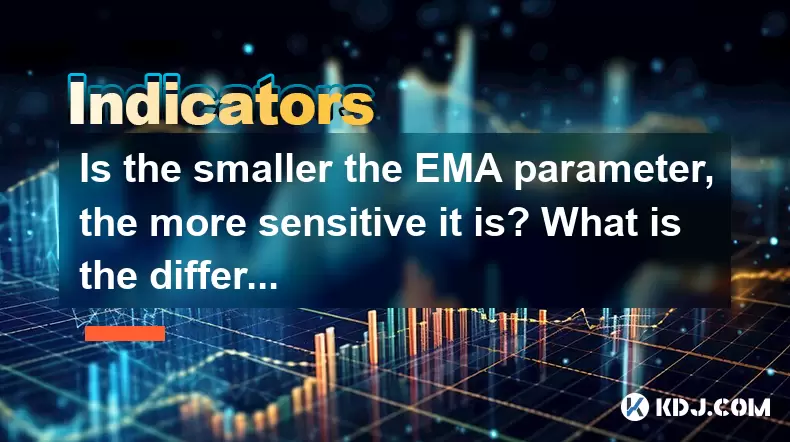
The Exponential Moving Average (EMA) is a popular technical indicator used by traders in the cryptocurrency market to analyze price trends and make informed trading decisions. The sensitivity of the EMA is determined by its parameter, which is the number of periods used in the calculation. In this article, we will explore whether a smaller EMA parameter results in a more sensitive indicator and examine the differences between the 5-day and 20-day EMAs.
Understanding EMA Sensitivity
The sensitivity of an EMA refers to how quickly it reacts to price changes. A more sensitive EMA will closely follow the price action, while a less sensitive one will be smoother and lag behind the price. The parameter of the EMA plays a crucial role in determining its sensitivity.
The smaller the EMA parameter, the more sensitive the indicator becomes. This is because a smaller parameter means that more weight is given to recent price data, causing the EMA to react faster to price changes. Conversely, a larger parameter assigns more weight to older price data, resulting in a smoother and less sensitive EMA.
Calculating EMA
To understand why a smaller parameter leads to increased sensitivity, let's look at the formula for calculating the EMA:
[ \text{EMA} = ( \text{Price} - \text{Previous EMA} ) \times \frac{2}{(\text{Parameter} + 1)} + \text{Previous EMA} ]
From this formula, we can see that the multiplier, (\frac{2}{(\text{Parameter} + 1)}), determines how much weight is given to the current price relative to the previous EMA. A smaller parameter results in a larger multiplier, causing the EMA to be more responsive to recent price changes.
Comparing 5-day and 20-day EMAs
Now that we understand the relationship between the EMA parameter and sensitivity, let's compare the 5-day and 20-day EMAs to see how they differ in practice.
5-day EMA
The 5-day EMA is a short-term indicator that is highly sensitive to price movements. It is calculated using the following steps:
- Choose the initial SMA: Calculate the Simple Moving Average (SMA) for the first 5 days.
- Calculate the multiplier: Use the formula (\frac{2}{(5 + 1)} = \frac{1}{3}).
- Calculate the EMA: For each subsequent day, apply the EMA formula using the current price, the previous EMA, and the multiplier.
The 5-day EMA is often used by traders who want to capture short-term trends and make quick trading decisions. It closely follows the price action and can help identify entry and exit points for short-term trades.
20-day EMA
The 20-day EMA is a longer-term indicator that is less sensitive to price movements compared to the 5-day EMA. It is calculated using the following steps:
- Choose the initial SMA: Calculate the Simple Moving Average (SMA) for the first 20 days.
- Calculate the multiplier: Use the formula (\frac{2}{(20 + 1)} = \frac{2}{21} \approx 0.095).
- Calculate the EMA: For each subsequent day, apply the EMA formula using the current price, the previous EMA, and the multiplier.
The 20-day EMA is commonly used by traders who are interested in medium-term trends. It smooths out short-term fluctuations and provides a clearer picture of the overall trend direction. This indicator is useful for identifying potential support and resistance levels and can help traders make more informed decisions about longer-term positions.
Practical Application of EMAs
Traders often use multiple EMAs with different parameters to gain a more comprehensive understanding of market trends. By comparing the 5-day and 20-day EMAs, traders can identify potential trading opportunities and confirm trend direction.
- Crossovers: When the 5-day EMA crosses above the 20-day EMA, it may signal a bullish trend, while a cross below may indicate a bearish trend.
- Divergence: If the price is making new highs, but the 20-day EMA is not following, it could suggest a weakening trend.
- Support and Resistance: The 20-day EMA can act as a dynamic support or resistance level, while the 5-day EMA can help identify short-term price reversals.
Using EMAs in Cryptocurrency Trading
In the cryptocurrency market, where prices can be highly volatile, the choice of EMA parameters can significantly impact trading strategies. Traders need to consider the specific characteristics of the cryptocurrency they are trading and adjust their EMA parameters accordingly.
- High Volatility: For cryptocurrencies with high volatility, such as Bitcoin or Ethereum, a shorter EMA like the 5-day can help traders capture short-term price movements and capitalize on quick trading opportunities.
- Lower Volatility: For more stable cryptocurrencies, a longer EMA like the 20-day may be more suitable for identifying medium-term trends and making more conservative trading decisions.
Frequently Asked Questions
Q: Can I use EMAs for all cryptocurrencies, or are they better suited for certain types?
A: EMAs can be used for all cryptocurrencies, but their effectiveness may vary depending on the specific characteristics of each cryptocurrency. For highly volatile cryptocurrencies, shorter EMAs like the 5-day may be more effective for capturing short-term trends, while longer EMAs like the 20-day may be better suited for less volatile cryptocurrencies to identify medium-term trends.
Q: How do I choose the right EMA parameter for my trading strategy?
A: The choice of EMA parameter depends on your trading style and the time frame you are focusing on. For short-term trading, a smaller parameter like 5 or 10 days may be more suitable, while for medium-term trading, a larger parameter like 20 or 50 days could be more effective. It's essential to backtest different EMA parameters and analyze their performance in the context of your specific trading strategy.
Q: Can I use EMAs in combination with other technical indicators?
A: Yes, EMAs are often used in combination with other technical indicators to enhance trading decisions. For example, traders may use EMAs alongside the Relative Strength Index (RSI) to confirm overbought or oversold conditions or combine them with the Moving Average Convergence Divergence (MACD) to identify potential trend changes. The key is to find a combination of indicators that complements your trading style and helps you make more informed decisions.
Q: How frequently should I update my EMA calculations?
A: The frequency of updating EMA calculations depends on your trading time frame and the specific cryptocurrency you are trading. For short-term trading, you may need to update your EMAs daily or even hourly to stay on top of price movements. For medium-term trading, weekly updates may be sufficient. It's crucial to align the frequency of your EMA updates with your overall trading strategy and the volatility of the cryptocurrency market.
Disclaimer:info@kdj.com
The information provided is not trading advice. kdj.com does not assume any responsibility for any investments made based on the information provided in this article. Cryptocurrencies are highly volatile and it is highly recommended that you invest with caution after thorough research!
If you believe that the content used on this website infringes your copyright, please contact us immediately (info@kdj.com) and we will delete it promptly.
- BOXABL Embraces Bitcoin to Boost Financial Flexibility
- 2025-05-26 07:15:13
- Bitcoin [BTC] Officially Enters Wyckoff Phase E—Golden Cross Sets the Stage for Next Market Cycle
- 2025-05-26 07:15:13
- Bitcoin Solaris (BTC-S): The Next XRP Boom?
- 2025-05-26 07:10:12
- Shiba Inu (SHIB) Price Prediction: Will the Memecoin Explode in a New Alt Season?
- 2025-05-26 07:10:12
- Binance Coin (BNB) is on an upward trend, currently trading at $673 after a 5% surge driven by growing confidence in the Binance ecosystem.
- 2025-05-26 07:05:13
- Bitcoin (BTC) Price Prediction: Willy Woo Predicts BTC Will Rally to $118k After Breaking ATH
- 2025-05-26 07:05:13
Related knowledge
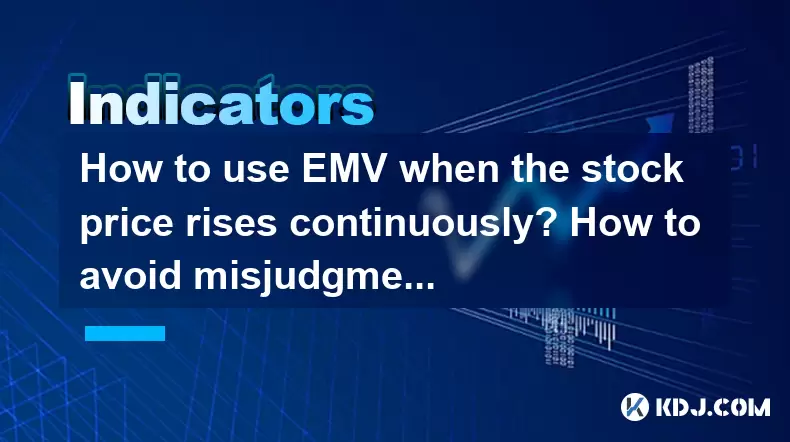
How to use EMV when the stock price rises continuously? How to avoid misjudgment in extreme market conditions?
May 23,2025 at 07:29pm
In the dynamic world of cryptocurrency trading, the Exponential Moving Average (EMA) is a powerful tool that traders use to make informed decisions, especially during periods of continuous stock price rises. Understanding how to effectively use EMAs and avoiding misjudgment in extreme market conditions are crucial skills for any crypto trader. This arti...
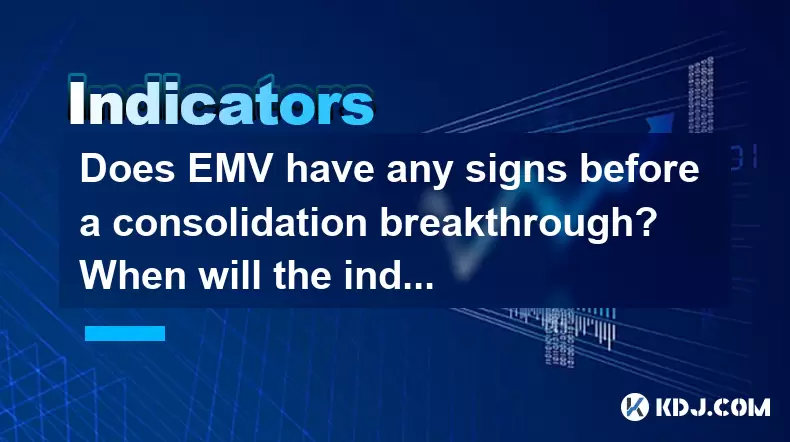
Does EMV have any signs before a consolidation breakthrough? When will the indicator give an early warning?
May 23,2025 at 06:42pm
Does EMV have any signs before a consolidation breakthrough? When will the indicator give an early warning? The Ease of Movement Value (EMV) is a technical indicator that helps traders understand the relationship between price and volume in the cryptocurrency market. It is particularly useful for identifying potential breakouts from consolidation period...
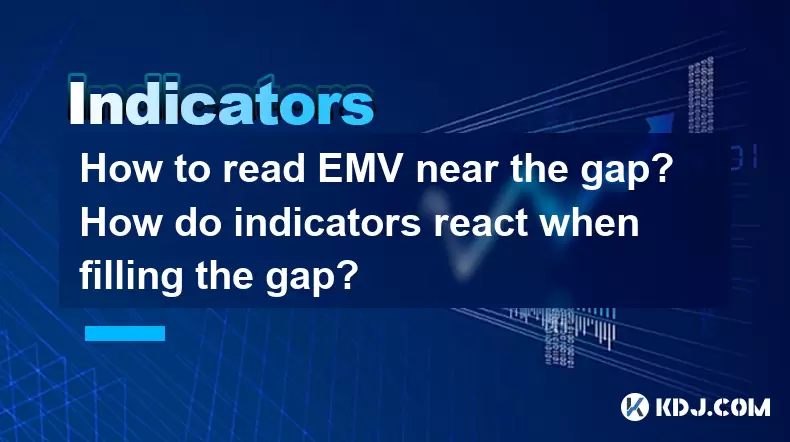
How to read EMV near the gap? How do indicators react when filling the gap?
May 25,2025 at 11:50pm
Understanding how to read EMV (Ease of Movement) near the gap and how indicators react when filling the gap is crucial for traders in the cryptocurrency market. This article will provide detailed insights into these concepts, helping you make more informed trading decisions. What is EMV and Why It Matters Near the GapEase of Movement (EMV) is a volume-b...
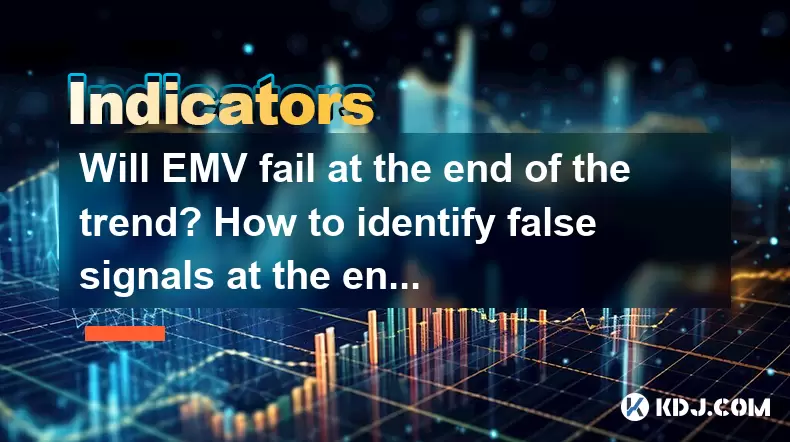
Will EMV fail at the end of the trend? How to identify false signals at the end of the market?
May 26,2025 at 12:57am
In the world of cryptocurrencies, the concept of Exponential Moving Average (EMV) plays a crucial role in technical analysis. Traders and investors use EMV to identify trends and potential reversals in the market. However, a common concern among crypto enthusiasts is whether EMV can fail at the end of a trend and how to identify false signals during the...
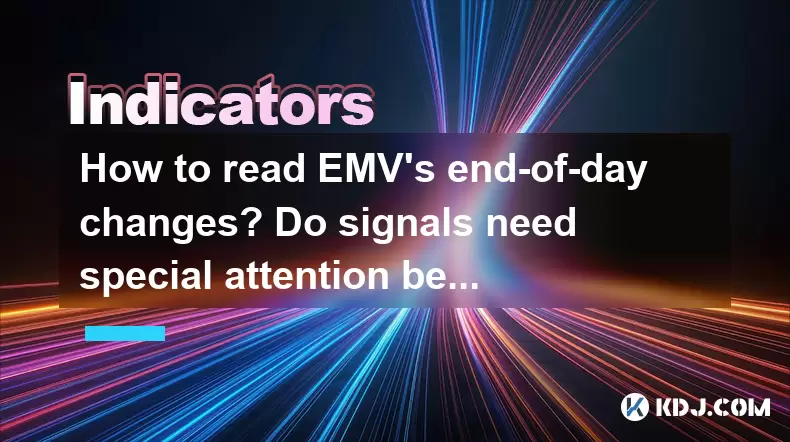
How to read EMV's end-of-day changes? Do signals need special attention before closing?
May 26,2025 at 07:21am
Understanding how to read EMV's end-of-day changes and whether signals require special attention before closing is crucial for traders and investors in the cryptocurrency market. EMV, or Ease of Movement, is a technical indicator that helps traders assess the relationship between price and volume. By analyzing EMV's end-of-day changes, traders can gain ...
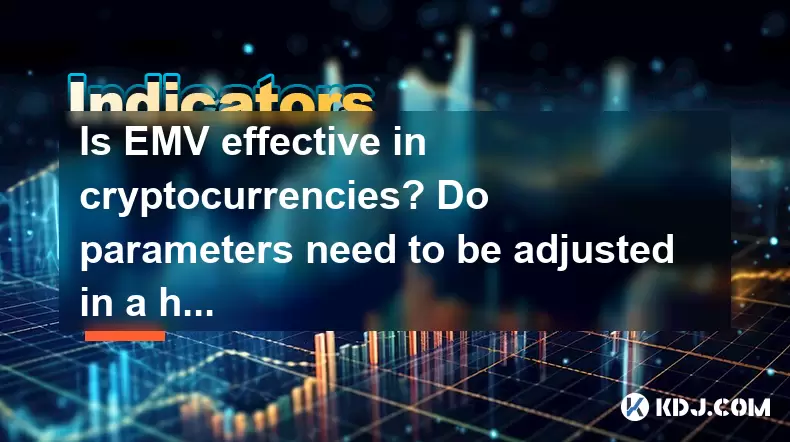
Is EMV effective in cryptocurrencies? Do parameters need to be adjusted in a high volatility environment?
May 24,2025 at 01:49am
Is EMV effective in cryptocurrencies? Do parameters need to be adjusted in a high volatility environment? EMV, or Ease of Movement Value, is a technical indicator that measures the relationship between price changes and volume. Originally developed for traditional financial markets, its application in the cryptocurrency space raises several questions ab...

How to use EMV when the stock price rises continuously? How to avoid misjudgment in extreme market conditions?
May 23,2025 at 07:29pm
In the dynamic world of cryptocurrency trading, the Exponential Moving Average (EMA) is a powerful tool that traders use to make informed decisions, especially during periods of continuous stock price rises. Understanding how to effectively use EMAs and avoiding misjudgment in extreme market conditions are crucial skills for any crypto trader. This arti...

Does EMV have any signs before a consolidation breakthrough? When will the indicator give an early warning?
May 23,2025 at 06:42pm
Does EMV have any signs before a consolidation breakthrough? When will the indicator give an early warning? The Ease of Movement Value (EMV) is a technical indicator that helps traders understand the relationship between price and volume in the cryptocurrency market. It is particularly useful for identifying potential breakouts from consolidation period...

How to read EMV near the gap? How do indicators react when filling the gap?
May 25,2025 at 11:50pm
Understanding how to read EMV (Ease of Movement) near the gap and how indicators react when filling the gap is crucial for traders in the cryptocurrency market. This article will provide detailed insights into these concepts, helping you make more informed trading decisions. What is EMV and Why It Matters Near the GapEase of Movement (EMV) is a volume-b...

Will EMV fail at the end of the trend? How to identify false signals at the end of the market?
May 26,2025 at 12:57am
In the world of cryptocurrencies, the concept of Exponential Moving Average (EMV) plays a crucial role in technical analysis. Traders and investors use EMV to identify trends and potential reversals in the market. However, a common concern among crypto enthusiasts is whether EMV can fail at the end of a trend and how to identify false signals during the...

How to read EMV's end-of-day changes? Do signals need special attention before closing?
May 26,2025 at 07:21am
Understanding how to read EMV's end-of-day changes and whether signals require special attention before closing is crucial for traders and investors in the cryptocurrency market. EMV, or Ease of Movement, is a technical indicator that helps traders assess the relationship between price and volume. By analyzing EMV's end-of-day changes, traders can gain ...

Is EMV effective in cryptocurrencies? Do parameters need to be adjusted in a high volatility environment?
May 24,2025 at 01:49am
Is EMV effective in cryptocurrencies? Do parameters need to be adjusted in a high volatility environment? EMV, or Ease of Movement Value, is a technical indicator that measures the relationship between price changes and volume. Originally developed for traditional financial markets, its application in the cryptocurrency space raises several questions ab...
See all articles






















































































